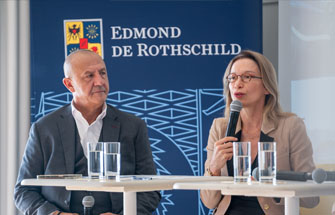On Tuesday morning at the Monte-Carlo Bay, Edmond de Rothschild Monaco hosted an exceptional conference bringing together Gérard Ohresser, CEO of Edmond de Rothschild Monaco, Mathilde Lemoine, Chief Economist of the Edmond de Rothschild Group, Charles Caudrelier, and Cyril Cyril Dardashti, respectively skipper and managing director of Gitana Team, around a common theme: how to navigate in a world where uncertainty is becoming the norm?
Gérard Ohresser: Many entrepreneurs today tell us that the world is more uncertain than ever. Is this just an impression?
Mathilde Lemoine: It's not just an impression, it's a measured reality. Uncertainty has increased according to all our indicators. To understand this properly, we need to distinguish between uncertainty and risk. Risk is probabilistic and insurable: you can insure yourself against an accident, for example. Uncertainty, on the other hand, is a state, an uncertain future potential that cannot be probabilized, and this radically changes economic behavior because it cannot be guarded against.
Since 2001, the global uncertainty indicator has doubled. Even more striking, it has tripled since Donald Trump's election in 2016. Uncertainty is therefore no longer a one-off phenomenon, but a structural trend that has accelerated in recent years.
G.O: What are the main causes?
M.L: The indicators detail several components of uncertainty:
🔹 Geopolitical uncertainty remains relatively low today, contrary to what one might think. It peaked in 2001 with the September 11 attacks and China's entry into the WTO, but remains half that level today.
🔹 Uncertainty surrounding trade policies has skyrocketed since 2016 with the rise of protectionism, tariffs, and strategic subsidies. This indicator has increased 35-fold since the end of 2016.
🔹 Finally, uncertainty surrounding economic policies has been steadily increasing since the 2008 financial crisis. It reflects the perception among businesses, households, and investors that governments are failing to provide adequate responses to current changes, whether in relation to the energy transition, financial crises, or the war in Ukraine.
What are the economic consequences of this increased uncertainty?
They are significant. First, uncertainty causes investment decisions to be postponed. Nearly 50% of companies consider it an obstacle to investment. This leads to aging production capacity and slower productivity growth. In concrete terms, a 10% increase in the uncertainty index translates into a 1% decline in global industrial production. That is considerable.
Second, uncertainty has powerful effects on financial markets:
🔹 It causes strong demand for assets considered safe, changing their relative prices (e.g., US sovereign bonds).
🔹 It creates a domestic bias: investors favor their domestic markets. Americans buy more US bonds, Europeans buy more European bonds, and so on. This regionalization of the asset market reflects the regionalization of trade.
In light of this, how are you adapting your work as an economist?
The big difference today is that we have to factor uncertainty into the equation. There is no longer any normality. We have to abandon traditional economic models based on a single average and a return to the trend. It is no longer a question of saying, “After a shock, growth will return to its trend path.” That no longer works.
We now work with:
✅ Probabilistic multi-scenario models, incorporating uncertainty as a structural factor.
✅ Decision trees, based on different possible scenarios.
✅ Abandoning assumptions of normality and linearity: the world is no longer linear; it jumps from one trend to another. Interdependencies are non-linear.
In short, we believe that the future is no longer a simple extrapolation of the past, but a broader field of possibilities requiring humility and strategic agility.
What recommendations can be made to governments and businesses in this context?
For governments:
- Prioritize automatic stabilizers (e.g., unemployment benefits, adaptable taxation) rather than discretionary policies adopted in emergencies, which are often inappropriate.
- Improve the clarity and transparency of communication on budgetary and monetary matters.
- Include review clauses to assess and adjust policies rather than assuming they will remain relevant forever.
For businesses:
- Develop strategies based on optionality, maintaining room for maneuver to adapt to possible futures.
- Strengthen their operational resilience by investing heavily in human capital: maintaining the skills and adaptability of teams is directly correlated with performance in uncertain environments.
Are economic forecasts too psychological these days?
That's a fascinating question. Indeed, the unpredictability of human behavior, such as that of Donald Trump, is pure uncertainty and impossible to model. But macroeconomics remains based on robust interdependencies. For example, current US policy aims for industrial autonomy, even if this sacrifices household consumption. This consistency can be analyzed. However, the transition between two systems (e.g., from Bretton Woods to another model) remains an area of inevitable uncertainty.
🔹 “The real mistake would be to continue to reason based on assumptions of normality. Uncertainty is no longer a hazard, it is a structural fact. Fully integrating it means preparing ourselves with clarity for the world of tomorrow.”






